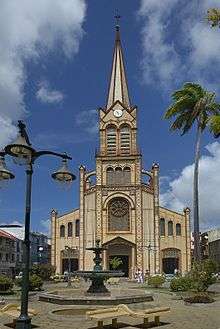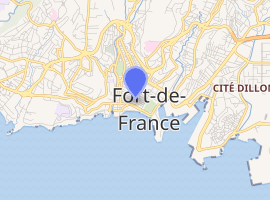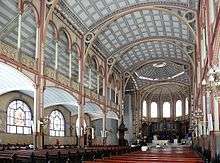St. Louis Cathedral, Fort-de-France
St. Louis Cathedral (French: Cathédrale Saint-Louis de Fort-de-France) is a Catholic cathedral located in Martinique, an overseas department of France. It was built in the late 19th-century in the Romanesque Revival style and serves as the cathedral of the Roman Catholic Archdiocese of Fort-de-France. The church is situated in the downtown area of the capital Fort-de-France, at the intersection of rue Victor Schoelcher and rue Blénac.
| St. Louis Cathedral Cathédrale Saint-Louis de Fort-de-France (in French) | |
|---|---|
 St. Louis Cathedral, Fort-de-France | |

| |
| Location | Rue Blénac, Fort-de-France |
| Country | |
| Denomination | Roman Catholic |
| Website | martinique |
| History | |
| Status | Cathedral |
| Consecrated | 1895 |
| Architecture | |
| Functional status | Active |
| Heritage designation | Monument Historique n° PA00105958, 1990[1] The construction of the cathedral began in the mid-17th century and it opened in 1657. |
| Architect(s) | Pierre-Henri Picq |
| Architectural type | church |
| Style | Romanesque Revival |
| Groundbreaking | 1891 |
| Completed | 1895 |
| Administration | |
| Archdiocese | Roman Catholic Archdiocese of Fort-de-France |
| Clergy | |
| Archbishop | David Macaire |
The construction of the cathedral began in the mid-17th century and it opened in 1657. Due to the natural disasters that have plagued Fort-de-France over the years, the current structure dates back to 1895 and was built with an iron frame in order to withstand these calamities. It is the seventh church to be erected on the site; it was built by Pierre-Henri Picq.[2]
History
Before the present cathedral was completed in 1895, a total of six churches had previously been constructed on the site, the first of which was built in 1657.[3] These were all destroyed by either fire, earthquakes or hurricanes.[2][4] The loss of significant buildings was not uncommon in Fort-de-France, as devastating natural disasters frequently plagued the region.[3] The cathedral that immediately preceded the present one was destroyed by fire in July 1890, a disaster that also obliterated three-quarters of the town.[5] Pierre-Henri Picq was hired to be the architect.
In the mid-1970s,[6] the cathedral underwent an extensive program of restoration and refurbishment. Part of this entailed repainting the exterior to a tan and brown colour.[7] The renovation was completed in 1978.[2] The cathedral is one of the most famous landmarks in the capital[8] and has been labelled "the religious centrepiece" of Martinique.[9]
Architecture

Exterior
St. Louis Cathedral was built in a Gothic Revival style[1] with rounded arches in the Neo-Romanesque style.[10] The cathedral's façade features a steeple that rises 187 feet (57 m) above the city,[8] while its exterior walls are supported by flying buttresses.[7] Located in front of the cathedral is a small square that contains two royal palms which appear to flank the structure.[8] The building is located directly across the square from the consulate of the United States[7] and is one block northwest from the park La Savane.[8]
The entire structure has a frame of iron beams which support the walls, ceiling and steeple making the church a fine example of architecture from the time of the Industrial Revolution.[11] As a result, the cathedral is referred to in the Caribbean as the "Iron Cathedral"[2] and has been compared to a "Catholic railway station".[9][11]
Interior
The interior of the church is noted for its "grand organ",[10] ornate walls,[12] beautiful stained glass windows and balustrade made of iron.[2] Located underneath the choir loft is a crypt containing the tombs of several previous governors of Martinique.[9]
References
- "Monument historique — PA00086250". Mérimée database of Monuments Historiques (in French). France: Ministère de la Culture. 1993. Retrieved 5 October 2013.
- Gravette, Andrew Gerald (2000). Architectural Heritage of the Caribbean: An A–Z of Historic Buildings. Signal Books. pp. 238–239. ISBN 9781902669090. Retrieved June 18, 2013.
- Riding, Alan (July 7, 1991). "Two islands are hybrids of France". The Gainesville Sun. p. 9D. Retrieved June 18, 2013.
- Fodor's Martinique, Dominica & Guadeloupe. Random House LLC. December 28, 2010. p. 28. ISBN 9780307927941. Retrieved October 2, 2013.
- "Wiped Out By Fire". Detroit Free Press. July 11, 1890. p. 1. Retrieved October 2, 2013. (subscription required)
- Thompson, David (September 17, 1977). "Sightseeing in Martinique". The Virgin Islands Daily News. p. 15. Retrieved June 18, 2013.
- Sutton, Horace (May 20, 1979). "Everything but Brigitte". The Boston Globe. p. C3. Retrieved September 27, 2013. (subscription required)
- Gorry, Conner (2005). Caribbean Islands. Lonely Planet. p. 565. ISBN 9781741040555. Retrieved September 27, 2013.
- Porter, Darwin; Prince, Danforth (September 15, 2005). Frommer's Caribbean 2006. John Wiley & Sons. p. 423. ISBN 9780471748755. Retrieved October 3, 2013.
- Riley, Frank (September 20, 1987). "Martinique Sparkles as French Caribbean Jewel". Los Angeles Times. Retrieved September 27, 2013.
- Sarna, Heidi; Hannafin, Matt (August 27, 2004). Frommer's Caribbean Ports of Call. John Wiley & Sons. p. 224. ISBN 9780764568992. Retrieved October 3, 2013.
- Sarna, Heidi; Hannafin, Matt (February 20, 2007). Cruise Vacations For Dummies 2007. John Wiley & Sons. p. 347. ISBN 9780470106259. Retrieved October 3, 2013.
External links
| Wikimedia Commons has media related to Cathédrale Saint-Louis de Fort-de-France. |